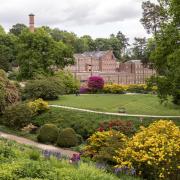Cheshire Wildlife Trust takes a tour of the sights and sounds that make summer in the county naturally uplifting.
Ah, summer. Waking up to the smell of freshly cut grass, watching the heatwaves rippling up into the atmosphere from the garden shed as the sun beams down on it, listening to the distinctive wood pigeons calling in the nearby trees... Those are the memories of my childhood.
By day, colours zip and dart along the waterside as kingfishers and dragonflies go about their business of hunting. Butterflies flit between flowers, reptiles bask in the sun, and seabirds clamour on the cliffsides.
The activity goes on under cover of darkness – bats sweep swiftly through the air, natterjacks chatter and nightjars churr, while glow-worms adorn the night with pinpricks of light.
Here is a rundown of some of my favourite things you can see, hear and do and the places to visit to help you get the most of the season
Things to see

Basking reptiles
Did you know we have six native species of reptile in the UK: three lizard and three snake species that have evolved from prehistoric beginnings to the wonderful reptiles we see today. They’re perhaps not classed as the most exciting creatures when talking about wildlife in the UK, but to me they’re definitely fascinating.
On a hot summer’s day, you might be lucky enough to come across one basking on a rock to warm itself before running off into the undergrowth. These creatures are more than worth the wait to see. Sadly, due to loss of habitat, both smooth snakes and sand lizards are very rare, which makes a sighting even more spectacular. It's so important we protect important habitats to ensure we do not lose our native reptiles.

Wonderful wildflowers
Though wildflowers in Cheshire are scarce, when planted they provide the perfect food source for our buzzy friends, and important habitats for our butterflies, beetles and moths. Without these amazing pollinators, we wouldn’t have fruits, vegetables and many other foods.
They’re our underrated heroes who need us to shout from the rooftops on how important they are for our and many other species' survival.
Fortunately, we can do something about our wildflower meadows in Cheshire. We can all play a part in creating the change that’s needed to support our heroes – in our own patches at home or community.
Gardens don’t need to be big to make a difference, even a balcony in the middle of a city can be enough. Wild hanging baskets, mini meadow patches at the bottom of the garden, wildflowers in an old paint tin – nothing is too small if enough gardens do it together.
Beautiful heather
Heather is my absolute favourite thing to look out for during summer. Their delicate, loosely arranged pink flowers attract all kinds of nectar-loving insects. There are three species of heather to look out for in the summer and early autumn:
Ling
The delicate pink flowers of common heather or ling appear from August to October and are a contrast to the tough, wiry, sprawling stems they grow upon. Plants grow tightly packed together and can live for up to 40 years or more.
Bell heather
Bell heather particularly likes acidic, dry, well-drained soils. The dark purple-pink, bell-shaped flowers appear between July and September, carpeting heathlands and bringing them to life with the buzzing of nectar-loving bees and insects.
Cross-leaved heath
This is a type of heather getting its name from the distinctive whorls of four leaves that occur along its stems.
An evergreen shrub, it prefers acid bogs and wet heath or moorland. It flowers between June and September and attracts many nectar-loving insects, including bees and moths.
Bats
Whether you are watching them in woodlands or skimming over a river, the sight of a bat is truly wonderful, especially on a warm summer evening.
Britain is home to 18 species of bat – the largest being the noctule which weighs as little as four £1 coins, and the smallest, the pipistrelle, weighing as little as a 2p coin.
Things you can hear
Skylarks
Ah the skylark, I love listening to its call while out walking in the countryside. It is so distinctive, it almost sounds like the old internet dial-up tone. You can spot them hovering above the ground before parachuting down back to earth. These long and complicated song-flights can last for up to an hour.

Swallows
A sight I’m always happy to see during the spring and summer months is the return of the swallow (also known as the barn swallow), after its migration back from Africa.
They love to build their nests out of straw and mud, preferably on ledges but often found in old farm buildings or outhouses.
Swifts
Look up to the skies during the summer and you’ll be met with the beautiful view of swifts whirling above. The swift will spend most of their lives soaring high in the sky, only ever landing to nest. They are easy to spot as they look like an arrow whirling through the sky, and often fly in groups. Originally, they would have nested in trees or cliffs but now prefer the roofs of old buildings like churches. Swifts spend the winter in Africa but travel to Britain every year in April and May.
Places to go

Swettenham
Situated in the heart of the Swettenham Valley near Holmes Chapel, Swettenham really is one of Cheshire’s gems: ancient woodland, a network of wildlife-rich ponds, scrub and a series of species-rich meadows intersected by numerous wet springs and flushes adding to the diversity of the area. All of this amazing habitat supports an abundance of wildlife most notably valuable populations of 14 resident species of butterfly.
Danes Moss
Danes Moss Nature Reserve near Macclesfield is a real gem. It truly is an oasis of lowland-raised bog – one of the scarcest and most threatened habitats in the UK. It’s also the perfect place to see those basking common lizards too as they relax on the boardwalk that cuts through the reserve.

Bickley Hall Farm
Bickley Hall Farm is a wildlife haven with wildflowers, ponds, wild bird seed crops to help birds through the winter, wet grassland and hedgerows. It’s a beautiful place to visit in the summer.
The farm is managed by Cheshire Wildlife Trust as an organic, wildlife-friendly farm in partnership with a local grazier. The grazing partner provides the cattle for the trust to manage the farm and grows a spring-sown cereal in locations determined by the trust. The great sandstone trail goes through the farm so you can even pass through on your walk.
Cleaver Heath
If you’d love to visit a reserve full of heather this summer, Cleaver Heath is the place. With stunning views sweeping across the Dee estuary, Cleaver Heath is an important heathland on the Wirral and the perfect reserve for an evening stroll at sunset. On a clear day, you can even see Snowdonia.
A carpet of purple shades of heather and bright yellow gorse in summer is bisected by a footpath running lengthways through the reserve allowing close-up views of the heathland plants and insects. You may be lucky and come across a common lizard basking on the paths or scuttling from one side to the other.
What you can do
Create a nectar café for your garden
Many of our prettiest insects feed on nectar, so need flowering plants for their survival. Butterflies, moths, bees and hoverflies all need sources of nectar and pollen to thrive. As they travel from flower to flower, they also pollinate them, enabling them to set seed or bear fruit.
So, setting up a nectar café benefits both your plants and you, allowing you to enjoy the flitting and fluttering of beautiful butterflies. Find out how you can create one here: www.cheshirewildlifetrust.org.uk/actions/plant-flowers-bees-and-pollinators
We have loads of ways you can take action for wildlife this year. From how to create your own pond, to building your own nest box. Take a look on our website: https://www.cheshirewildlifetrust.org.uk/actions
Share your photos, videos and stories on how you plan on taking action for wildlife this year on our social media channels.

























![Stephen Webb [Frank-N-Furter], Richard Meek [Brad], Haley Flaherty [Janet] & cast](/resources/images/128x89/1x/17679473.jpg)
![Stephen Webb [Frank-N-Furter], Richard Meek [Brad], Haley Flaherty [Janet] & cast](/resources/images/180x180/1x/17679473.jpg)
